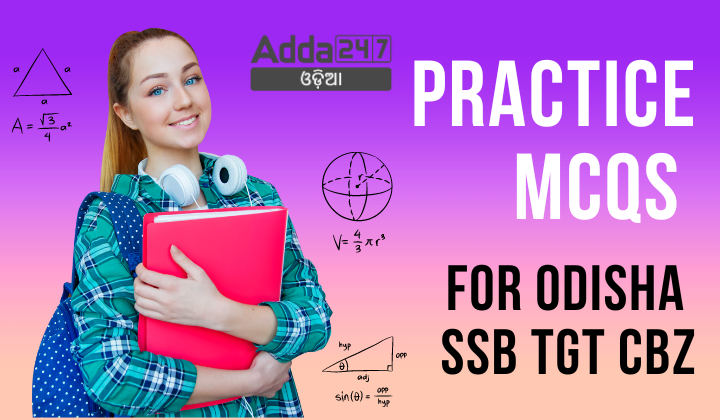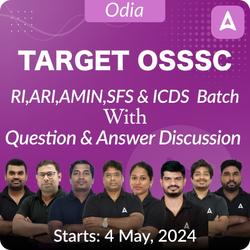Practice MCQs for Odisha SSB TGT CBZ 05 June 2024
- The term “Pedagogy” primarily refers to:
A. Teaching methods
B. Classroom management
C. Curriculum development
D. Student assessment
Answer: A - Pedagogy is concerned with the:
A. Process of learning
B. Art of teaching
C. Creation of educational policies
D. Evaluation of educational systems
Answer: B - Which of the following measures a child’s physical growth?
A. Behavioral changes
B. Quantitative analysis
C. Qualitative assessment
D. Psychological tests
Answer: B - The most effective method to study a child’s growth and development is:
A. Comparative studies
B. Longitudinal research
C. Cross-sectional analysis
D. Psychoanalytic method
Answer: B - Using technology to improve the learning experience is known as:
A. IT in education
B. ICT in education
C. E-learning
D. Digital pedagogy
Answer: B - PSRN in child development stands for:
A. Problem Solving, Reasoning, and Numeracy
B. Perceptual Skills, Reasoning, and Numeracy
C. Problem Solving, Relationship, and Numeracy
D. Perceptual Skills, Relationship, and Numbers
Answer: B - “Learning through making mistakes” is based on which theory?
A. Classical conditioning
B. Trial and Error
C. Insight learning
D. Operant conditioning
Answer: B - To address individual differences, teachers should:
A. Understand each student’s abilities and interests
B. Customize the curriculum to meet students’ needs
C. Both A and B
D. Follow a strict uniform curriculum
Answer: C - When presenting new information, teachers should connect it to what students:
A. Do not know
B. Already know
C. Are curious about
D. Have forgotten
Answer: B - If a child’s mental age is 6 and chronological age is 4, the IQ is:
A. 100
B. 120
C. 150
D. 110
Answer: C - Which statement is false regarding growth and development?
A. Growth is a biological process
B. Development is a quantitative process
C. Education is a continuous process
D. Learning involves behavioral changes
Answer: B - Which of the following is not a tool for formative assessment?
A. Observation
B. Multiple Choice Questions
C. Projects
D. Summative tests
Answer: D - According to John Dewey, education is primarily a:
A. Philosophical process
B. Social process
C. Political process
D. Economic process
Answer: B - Special education focuses on:
A. Talented students
B. Disabled students
C. Teacher training programs
D. Remedial education
Answer: B - Which statement about multiple choice questions is incorrect?
A. Easy for inexperienced teachers to create
B. All choices should be plausible
C. Quick evaluation by computer
D. Only one correct answer
Answer: A - The ore of Aluminium is:
A. Bauxite
B. Chromium
C. Mica
D. Manganese
Answer: A - Which of the following molecules will have the strongest dipole-dipole interactions?
A. NH3 and CH4
B. CH4 and CH4
C. CO2 and CO2
D. NH3 and NH3
Answer: D - Compared to liquids, gases have:
A. Greater compressibility and smaller density
B. Greater compressibility and greater density
C. Smaller compressibility and smaller density
D. Smaller compressibility and greater density
Answer: A - Hydrogen bonding in water causes molecules to:
A. Repel each other
B. Attract each other
C. Compactly arrange
D. Slide over each other less easily
Answer: D - The predominant force affecting the boiling point trend HCl < HBr < HI is:
A. London dispersion forces
B. Dipole-dipole interactions
C. Hydrogen bonding
D. Dipole-induced dipole interactions
Answer: A - The DRDO-developed drug ‘Lukosin’ is used to treat:
A. Leukemia
B. Vitiligo (Leucoderma)
C. Lung cancer
D. Brain tumor
Answer: B - Which element is essential for hydrogen bonding?
A. Hydrogen
B. Sodium
C. Calcium
D. Sulfur
Answer: A - The balance between intermolecular forces and thermal energy results in:
A. Formation of solids
B. Formation of liquids
C. Formation of gases
D. The three states of matter
Answer: D - Diamond is harder than graphite due to its:
A. Difference in layers of atoms
B. Tetrahedral structure
C. Crystalline structure
D. All of the above
Answer: A - Bishrampur is famous for the mining of:
A. Copper ore
B. Iron ore
C. Coal
D. Manganese
Answer: C - Which plant hormone plays the most important role in establishing dormancy in seeds?
A. Ethylene
B. Gibberellic acid
C. Abscisic Acid
D. Auxin
Answer: C - Photosynthesis generally occurs in which parts of the plant?
A. Leaf and other chloroplast-bearing parts
B. Stem and leaf
C. Roots and chloroplast-bearing parts
D. Bark and leaf
Answer: A - Which element is crucial for photosynthesis?
A. Nitrogen
B. Phosphorus
C. Potassium
D. Magnesium
Answer: D - The movement of water from roots to leaves is mainly due to:
A. Osmosis
B. Diffusion
C. Transpiration pull
D. Capillary action
Answer: C - Which type of root system is characteristic of monocots?
A. Taproot system
B. Fibrous root system
C. Adventitious root system
D. None of the above
Answer: B - Which plant hormone is responsible for fruit ripening?
A. Auxin
B. Gibberellin
C. Ethylene
D. Cytokinin
Answer: C - In which part of the plant does primary growth occur?
A. Leaves
B. Roots and stems
C. Flowers
D. Fruits
Answer: B - Which pigment is primarily responsible for photosynthesis?
A. Chlorophyll
B. Carotene
C. Xanthophyll
D. Anthocyanin
Answer: A - Which process describes the movement of water through a plant?
A. Translocation
B. Transpiration
C. Phototropism
D. Photolysis
Answer: B - What is the primary function of root hairs?
A. Support
B. Storage
C. Water absorption
D. Photosynthesis
Answer: C - Poliomyelitis (Polio) is caused by a virus that has a particular affinity to:
A. Muscle Cells
B. Nerve Cells of Spinal Cord
C. Nerve Cells of Brain
D. None of the above
Answer: B - Which among the following conditions will give birth to Fraternal Twins?
A. A single egg is fertilized to form one zygote which then divides into two separate embryos
B. Sperm cells fertilize both the ovum and the second polar body
C. Two eggs are independently fertilized by two different sperm cells
D. None of the above
Answer: C - The bacterium ‘Escherichia coli’ is found mainly in:
A. Human Intestine
B. Pteridophytes
C. Root Nodules of leguminous plants
D. Paddy fields for nitrogen fixation
Answer: A - In the human body, the largest amount of carbon dioxide produced by body cells is carried to the lungs as:
A. CO2 attached to hemoglobin in the red blood cells
B. The bicarbonate ion attached to hemoglobin
C. CO2 gas in solution in the plasma
D. Bicarbonate ion dissolved in the plasma
Answer: D - Which of the following statements is incorrect about the large intestine?
A. It secretes a number of hormones
B. Villi are absent in the large intestine
C. It takes part in the absorption of water from the indigestible residue
D. The colon is also called the large intestine
Answer: A
Syndesmology is the study of which of the following?
A. Muscles
B. Joints of bones and ligaments
C. Earthquakes
D. Snakes
Answer: B - Which of the following facts is true regarding color blindness?
A. More common among women
B. Very rare in women
C. Very rare in men
D. Found to the same extent in both sexes
Answer: B - Which of the following pairs is/are correct?
A. Main root — Storage
B. Lateral root — Absorption
C. Root hair — Conduction
A. Only A
B. A and C
C. All are correct
D. None of the above
Answer: A - Which statement is incorrect about chordates?
A. They must have a notochord at every point of their life
B. They have a post-anal tail
C. They have a hollow dorsal nerve cord
D. They have a ventral heart
Answer: A - Branchiostoma is an example of:
A. Urochordata
B. Cephalochordata
C. Vertebrata
D. Agnatha
Answer: B - Which of the following is incorrect about Urochordata?
A. They are a classification under Protochordates
B. They have a post-anal tail only till their larval stage
C. Most of these are marine and almost extinct
D. They don’t contain gill clefts
Answer: D - Which is not correct about Vertebrata?
A. All chordates are vertebrates
B. In vertebrates, the notochord is replaced by the vertebral column in adults
C. They might not have a post-anal tail after a certain period of time
D. Notochord is present during the embryonic period
Answer: A - Agnatha is an example of:
A. Sub-phylum
B. Phylum
C. Super-class
D. Class
Answer: C - Which of the following is incorrect about Agnatha?
A. These are also called jawless fishes
B. Scales and fins are present
C. They adopt a parasitic mode of nutrition
D. They have a circular mouth that acts as a sucker
Answer: B - Which of the following is incorrect about Cyclostomata?
A. Their vertebral column is made of cartilage
B. Lamprey and hagfish are examples of this class
C. Their digestive system is complete with stomach, food pipe, and intestines
D. Their circulatory system is closed with a 2-chambered heart
Answer: C - The element that replaced eka-Aluminium in Mendeleev’s Periodic Table is:
A. Scandium
B. Gallium
C. Titanium
D. Germanium
Answer: B










